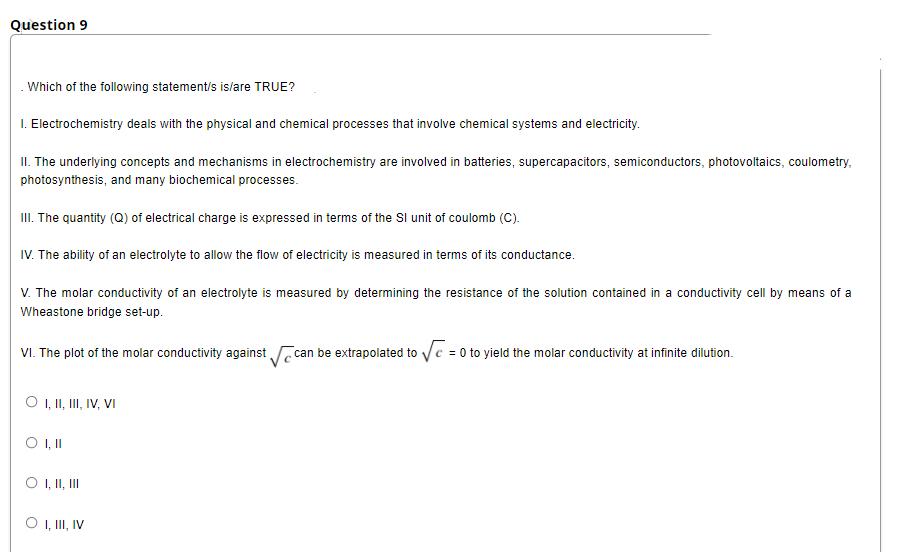. Which of the following statement/s is/are TRUE? I. Electrochemistry deals with the physical and chemical processes that involve chemical systems and electricity. II. The underlying concepts and mechanisms in electrochemistry are involved in batteries, supercapacitors, semiconductors, photovoltaics, coulometry, photosynthesis, and many biochemical processes. II. The quantity (Q) of electrical charge is expressed in terms of the SI unit of coulomb (C). IV. The ability of an electrolyte to allow the flow of electricity is measured in terms of its conductance. V. The molar conductivity of an electrolyte is measured by determining the resistance of the solution contained in a conductivity cell by means of a Wheastone bridge set-up. VI. The plot of the molar conductivity against can be extrapolated to Vc = 0 to yield the molar conductivity at infinite dilution.
. Which of the following statement/s is/are TRUE? I. Electrochemistry deals with the physical and chemical processes that involve chemical systems and electricity. II. The underlying concepts and mechanisms in electrochemistry are involved in batteries, supercapacitors, semiconductors, photovoltaics, coulometry, photosynthesis, and many biochemical processes. II. The quantity (Q) of electrical charge is expressed in terms of the SI unit of coulomb (C). IV. The ability of an electrolyte to allow the flow of electricity is measured in terms of its conductance. V. The molar conductivity of an electrolyte is measured by determining the resistance of the solution contained in a conductivity cell by means of a Wheastone bridge set-up. VI. The plot of the molar conductivity against can be extrapolated to Vc = 0 to yield the molar conductivity at infinite dilution.
General Chemistry - Standalone book (MindTap Course List)
11th Edition
ISBN:9781305580343
Author:Steven D. Gammon, Ebbing, Darrell Ebbing, Steven D., Darrell; Gammon, Darrell Ebbing; Steven D. Gammon, Darrell D.; Gammon, Ebbing; Steven D. Gammon; Darrell
Publisher:Steven D. Gammon, Ebbing, Darrell Ebbing, Steven D., Darrell; Gammon, Darrell Ebbing; Steven D. Gammon, Darrell D.; Gammon, Ebbing; Steven D. Gammon; Darrell
Chapter19: Electrochemistry
Section: Chapter Questions
Problem 19.32QP: You have 1.0 M solutions of Al(NO3)3 and AgNO3 along with Al and Ag electrodes to construct a...
Related questions
Question

Transcribed Image Text:Question 9
. Which of the following statement/s islare TRUE?
I. Electrochemistry deals with the physical and chemical processes that involve chemical systems and electricity.
II. The underlying concepts and mechanisms in electrochemistry are involved in batteries, supercapacitors, semiconductors, photovoltaics, coulometry,
photosynthesis, and many biochemical processes.
II. The quantity (Q) of electrical charge is expressed in terms of the Sl unit of coulomb (C).
IV. The ability of an electrolyte to allow the flow of electricity is measured in terms of its conductance.
V. The molar conductivity of an electrolyte is measured by determining the resistance of the solution contained in a conductivity cell by means of a
Wheastone bridge set-up.
VI. The plot of the molar conductivity against can be extrapolated to Vc = 0 to yield the molar conductivity at infinite dilution.
O , II, II, IV, VI
O , II, II
O , II, IV
Expert Solution
This question has been solved!
Explore an expertly crafted, step-by-step solution for a thorough understanding of key concepts.
Step by step
Solved in 3 steps with 3 images

Knowledge Booster
Learn more about
Need a deep-dive on the concept behind this application? Look no further. Learn more about this topic, chemistry and related others by exploring similar questions and additional content below.Recommended textbooks for you

General Chemistry - Standalone book (MindTap Cour…
Chemistry
ISBN:
9781305580343
Author:
Steven D. Gammon, Ebbing, Darrell Ebbing, Steven D., Darrell; Gammon, Darrell Ebbing; Steven D. Gammon, Darrell D.; Gammon, Ebbing; Steven D. Gammon; Darrell
Publisher:
Cengage Learning

Chemistry: The Molecular Science
Chemistry
ISBN:
9781285199047
Author:
John W. Moore, Conrad L. Stanitski
Publisher:
Cengage Learning

Principles of Modern Chemistry
Chemistry
ISBN:
9781305079113
Author:
David W. Oxtoby, H. Pat Gillis, Laurie J. Butler
Publisher:
Cengage Learning

General Chemistry - Standalone book (MindTap Cour…
Chemistry
ISBN:
9781305580343
Author:
Steven D. Gammon, Ebbing, Darrell Ebbing, Steven D., Darrell; Gammon, Darrell Ebbing; Steven D. Gammon, Darrell D.; Gammon, Ebbing; Steven D. Gammon; Darrell
Publisher:
Cengage Learning

Chemistry: The Molecular Science
Chemistry
ISBN:
9781285199047
Author:
John W. Moore, Conrad L. Stanitski
Publisher:
Cengage Learning

Principles of Modern Chemistry
Chemistry
ISBN:
9781305079113
Author:
David W. Oxtoby, H. Pat Gillis, Laurie J. Butler
Publisher:
Cengage Learning


Chemistry: An Atoms First Approach
Chemistry
ISBN:
9781305079243
Author:
Steven S. Zumdahl, Susan A. Zumdahl
Publisher:
Cengage Learning

Chemistry
Chemistry
ISBN:
9781305957404
Author:
Steven S. Zumdahl, Susan A. Zumdahl, Donald J. DeCoste
Publisher:
Cengage Learning